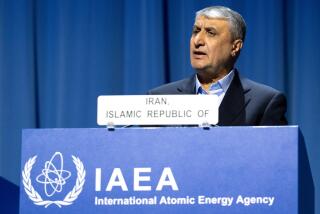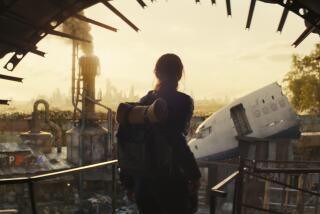Nation’s Reactors Suddenly Are Triggering Safety Concerns, Protests Japan’s ‘Nuclear Ginza’ Is Losing Its Luster
- Share via
KYOTO, Japan — Due north of here is a stretch of coastline noted for its fine scenery as well as for a somewhat more ambivalent distinction: having one of the highest concentrations of nuclear power plants in the world.
They call it the “Nuclear Ginza,” after Tokyo’s glittering shopping district, but the shore along Wakasa Bay on the Sea of Japan is beginning to lose some of its luster for the residents of nearby Kyoto.
Local residents are suddenly realizing that a third of all the nuclear reactors in Japan--12 out of 35--are located within about 40 miles of this city of 1.5 million. And anxious talk of radiation poisoning and contaminated food is replacing the silence that has surrounded the construction and operation of these facilities over the past 20 years.
Similarly, all across the country, anti-nuclear protests are moving from the isolated seaside communities where the reactors are built and taking root in the cities, where ordinary citizens now question their long-held belief that nuclear energy is clean and safe.
A grass-roots movement with few precedents in postwar Japan began two years ago, after the nuclear accident at Chernobyl in the Soviet Union sparked a controversy over imports of food contaminated by radioactive fallout. The protests rapidly gained momentum earlier this year, drawing 20,000 people, many of them housewives, to a Tokyo rally in April on the second anniversary of the Chernobyl accident.
Power industry officials have reacted with alarm.
“We’re extremely worried as we watch this happening,” said Takeo Tamai, a spokesman for the Federation of Electric Power Companies. “It doesn’t look like we can go ahead with projects as we have in the past. This is a new era for atomic energy in Japan.”
Resource-poor and enamored of technology, Japan is one of the few countries outside the East Bloc that still builds nuclear power plants, and it intends to continue doing so to cut its reliance on imported oil. As many as 18 new reactors are planned or under construction.
But if public protest continues unabated, the government may be forced to rethink its nuclear policy and possibly scrap its goal of increasing nuclear power from the present share of about 30% of total electrical generation to 40% by the end of the century.
Strong financial resources, combined with government-set rate structures that guarantee a “fair return” of 7.2% on capital investment, largely insulate the nine major power companies from the economic woes that have bogged down nuclear plant construction in the United States.
Still, declining oil prices, a surplus in domestic energy supply and rising consumer discontent over high electrical rates could contribute to a change in the economic formula behind nuclear power, critics say.
Moreover, it will become increasingly difficult for power companies to buy coastal land and negotiate with fishing cooperatives for compensation now that scattered local protests have the backing of urban activists.
“There’s a mental revolution going on in Japan,” said Takashi Hirose, a best-selling author and anti-nuclear activist. “We’re beginning to wake up after having our minds warped by deceptions and omissions in the mass media.”
Although they are subject to scientific dispute, Hirose’s outspoken views on the potential for serious nuclear accidents in Japan have galvanized the protest movement.
His book, “A Dangerous Story: Chernobyl and the Fate of Japan,” has sold more than 300,000 copies since it came out last year. He travels constantly, giving as many as 50 three-hour lectures a month to an array of citizens’ groups A local association of pharmacists in Kyoto, for example, recently sponsored one of his lectures.
Hirose maintains that numerous minor accidents and operational problems over the past several years have gone largely unreported in the mainstream news media. Though shutdowns are rare, he believes these incidents belie the industry’s safety claims and foreshadow an eventual disaster on the scale of Chernobyl or Three Mile Island, in Pennsylvania.
Tamai, the industry federation official, rejects such criticism. Japanese nuclear plants have the best safety record in the world, he contends, with fewer than one-tenth the number of shutdowns of other countries and an enviable 76% average rate of operation.
To correct “distortions” advanced by Hirose and others, the federation has spent more than $5.6 million on newspaper advertising since this year’s Chernobyl anniversary in April, trying to reassure people that Japan’s water-cooled nuclear reactors are far safer than the graphite reactor in Chernobyl.
“We admit that our efforts at working for public acceptance have been insufficient,” Tamai said. “Now that the problem has spread to the cities, we are going to have to reach out and explain things to ordinary citizens.”
The power companies have a lot of catching up to do in the public relations battle. A slim booklet by a woman from a small town on the southern island of Kyushu, for one, has sent shock waves through a spontaneous network of housewives and mothers.
Taeko Kansha, wife of a Zen priest in Nijo-machi, near the city of Fukuoka, heard Hirose speak at a seminar two years ago and was so disturbed that she wrote a long, open letter to friends to air her maternal worries about radioactive food. A Tokyo publisher printed the letter under the title “Is it Too Late?” The book has sold 450,000 copies, and is now available in English translation.
‘Left in the Dark’
“We’ve been left in the dark,” Kansha said. “Until I heard Mr. Hirose’s talk, I had no idea there was a problem, that things had gone this far. I wanted to reach out to people and express my feelings from a mother’s point of view.”
Ironically, the public’s traditionally passive acceptance of nuclear energy has contrasted with its attitudes about nuclear weapons. As the only people ever to be attacked with atomic weapons, the Japanese have what is often described as “nuclear phobia” and vehemently disavow the manufacture and deployment of nuclear warheads on their own soil. But they have embraced the concept of atoms for peace.
“People were hoping that this terrible weapon could be turned into something useful for humanity,” said Aileen Smith, an environmental activist in Kyoto. “It was the other side of the coin of their awareness of what a horrible thing atomic energy could be.”
The recent re-examination of the nuclear power industry also has raised questions about the effect that nuclear plants have on rural economies, as local opposition is often overcome by promises to improve roads, create new jobs and raise tax revenues. The result can be heavy dependence on a plant in depressed fishing towns whose youth have fled to urban employment centers.
“It’s not just a problem of potential pollution by radioactivity,” said Tetsuen Nakajima, a Buddhist priest and anti-nuclear activist in Obama, in the center of the “Nuclear Ginza” strip north of Kyoto where three new reactors are under construction.
“It’s spoiling rural societies with all kinds of unnatural flows of money,” Nakajima said. “People’s hearts are being warped, and locals are depending so much on money from the nuclear power plants that it becomes a drug that traps them.”
There are signs that these dynamics could be changing, however. In the coastal town of Hikigawa on the Kii Peninsula, voters in July elected a mayoral candidate who campaigned in opposition to the construction of a local nuclear power plant. This came 12 years after Kansai Electric Co. reportedly helped to rescue the town from an economic crisis by buying $1 million worth of land.
“The message is that it is getting difficult to build nuclear power plants in depopulated areas by distributing money,” the Asahi newspaper wrote in an editorial. “The electric companies must accept the public’s strongly held distrust of nuclear power plants.”
New Dimension
In Tokyo, a group called the Citizens’ Nuclear Information Center added a new political dimension to the controversy last month by starting a petition drive calling for a law that would freeze construction of new reactors and eventually phase out operating plants.
“I think we’ve turned the tide against the new plants,” said Jinzaburo Takagi, head of the center. “The problem now is what to do with the ones that already exist.”
So far, Takagi admits he has received only tentative signs of interest from Parliament members, but he hopes for nonpartisan sponsorship when legislation is drafted.
“We’ve talked a little bit,” he said. “Things are going to start getting really serious from now on.”
More to Read
Sign up for Essential California
The most important California stories and recommendations in your inbox every morning.
You may occasionally receive promotional content from the Los Angeles Times.










